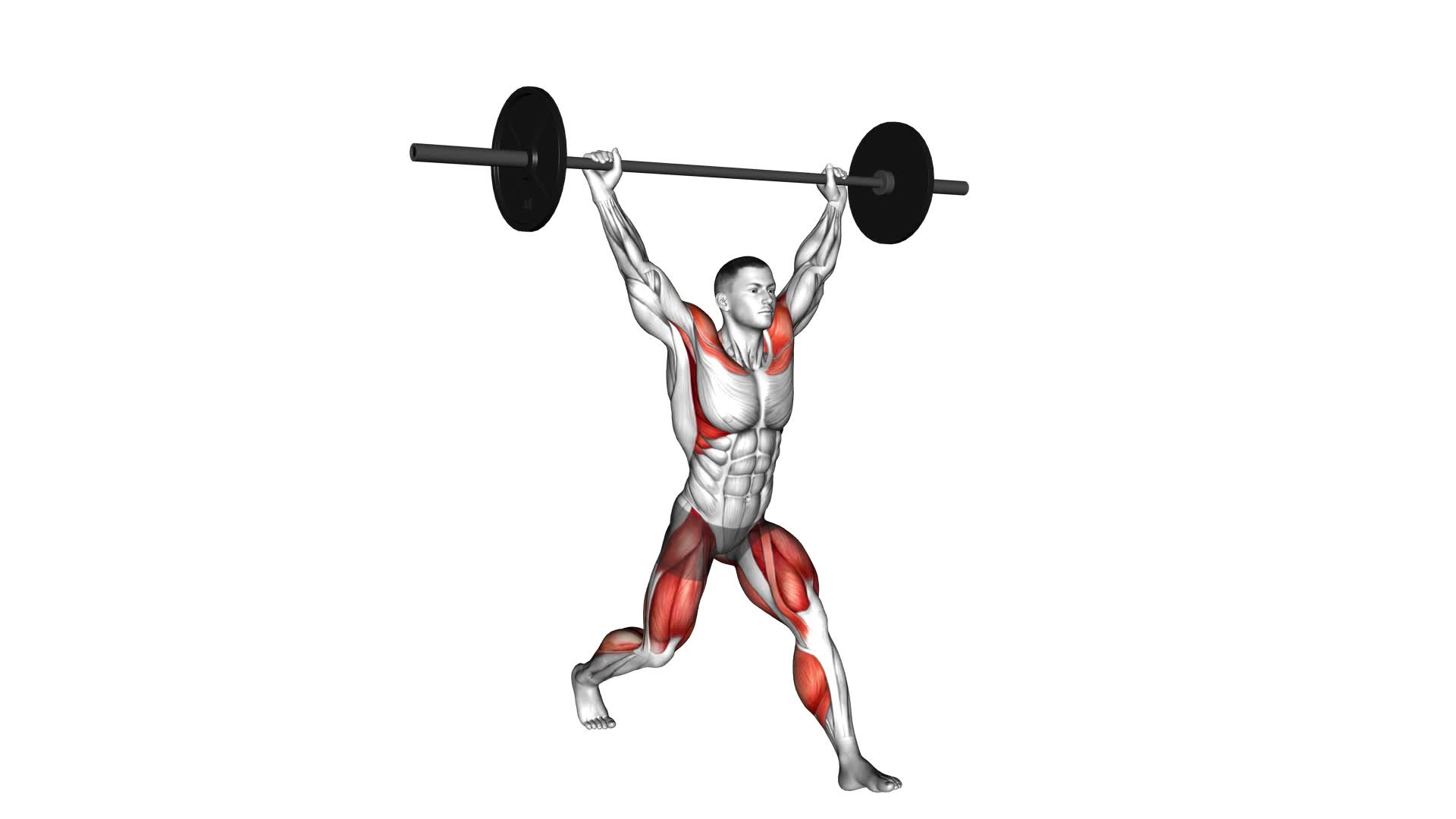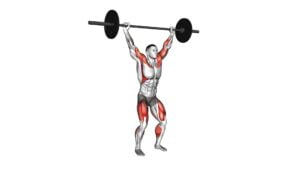Barbell Split Snatch – Video Exercise Guide & Tips

Are you looking to improve your strength and power? Then the barbell split snatch is the exercise for you.
Watch This Exercise Video
In this video exercise guide, we'll show you the proper technique and form to maximize your results. Avoid common mistakes and learn valuable tips to take your split snatch to the next level.
With variations and progressions, you can customize your workout.
Stay safe and get ready to elevate your fitness with the barbell split snatch.
Key Takeaways
- The barbell split snatch is beneficial for developing strength and power, improving footwork and muscle activation, enhancing stability and balance, and activating multiple muscles in the body.
- Proper technique and form for the barbell split snatch include focusing on foot positioning, maintaining barbell stability, using a strong grip on the barbell, and engaging the core for stability.
- Foot positioning is crucial for balance control and stability, with the front foot pointing straight ahead, the back foot turned out slightly, and equal weight distribution between the two feet.
- Techniques for improving barbell stability include practicing holding the barbell in the split snatch position, performing barbell overhead holds, and strengthening the muscles involved in maintaining stability.
Benefits of the Barbell Split Snatch
You will frequently experience the benefits of the Barbell Split Snatch. This exercise not only helps in developing strength and power, but it also improves your footwork and muscle activation.
The footwork involved in the Barbell Split Snatch is crucial for stability and balance. As you perform the exercise, you'll learn to position your feet correctly, with one foot forward and the other behind, allowing for a strong and stable base. This footwork not only enhances your overall performance but also helps in preventing injuries.
Additionally, the Barbell Split Snatch activates multiple muscles in your body, such as your quadriceps, hamstrings, glutes, and core. As you explosively lift the barbell overhead, these muscles are engaged to generate power and stability. This exercise also activates your upper body muscles, including your shoulders, triceps, and upper back.
By incorporating the Barbell Split Snatch into your workout routine, you can improve your overall athletic performance and enhance your muscle strength and coordination.
Now, let's dive into the next section to learn about the proper technique and form for the barbell split snatch.
Proper Technique and Form for the Barbell Split Snatch
To perform the Barbell Split Snatch with proper technique and form, there are two key points to focus on:
- Foot positioning: Your feet should be positioned in a staggered stance, with one foot forward and the other foot back, to provide a solid base.
- Barbell stability: You should use techniques like a strong grip on the barbell and tight core engagement to maintain stability throughout the movement.
Foot Positioning Importance
Proper foot positioning is crucial for executing the Barbell Split Snatch with optimal technique and form. When performing this exercise, you need to pay close attention to your foot placement to ensure balance control and stability throughout the movement.
To start, position your feet hip-width apart, with one foot slightly staggered in front of the other. The front foot should be pointing straight ahead, while the back foot is turned out at a slight angle. This positioning allows for a solid base and helps maintain stability during the lift.
The front foot should bear most of the weight, while the back foot serves as a supportive base. As you execute the Barbell Split Snatch, focus on maintaining equal weight distribution between the two feet, allowing for efficient power transfer and control.
Proper foot positioning sets the foundation for the subsequent section on barbell stability techniques.
Barbell Stability Techniques
To maintain proper technique and form for the Barbell Split Snatch, focus on implementing effective barbell stability techniques.
Improving balance in the split snatch is crucial to executing the movement safely and efficiently. Incorporating barbell stability drills into your training routine can help you achieve this.
One technique to improve stability is to practice holding the barbell in the split snatch position for extended periods of time. This helps strengthen the muscles involved in maintaining balance.
Another drill is the barbell overhead hold, where you lift the barbell overhead and hold it steady for a set amount of time. This exercise challenges your stabilizing muscles and improves your ability to maintain control during the split snatch.
Common Mistakes to Avoid During the Barbell Split Snatch
You should avoid these common mistakes during the barbell split snatch to ensure proper form and prevent injury. Here are four technique refinements to keep in mind:
- Incorrect foot positioning: One of the most common mistakes is placing your feet too close together or too far apart. This can affect your stability and balance during the lift. Make sure your front foot is directly under your knee, and your back foot is slightly behind your hips.
- Lack of hip extension: Failing to fully extend your hips can limit the power generated during the lift. Remember to forcefully extend your hips and drive through your heels to generate maximum upward momentum.
- Insufficient overhead stability: Many people struggle with maintaining stability overhead during the split snatch. It's crucial to engage your core and actively press the bar overhead, locking out your arms and keeping the bar directly above your head.
- Poor timing and coordination: The split snatch requires precise timing and coordination between your upper and lower body. Failing to synchronize your movements can lead to loss of balance and potential injuries. Focus on timing your split with the bar reaching its maximum height.
By avoiding these common mistakes, you can perform the barbell split snatch with proper form and reduce the risk of injury.
Now, let's move on to the next section and discuss tips for maximizing your results with the barbell split snatch.
Tips for Maximizing Your Results With the Barbell Split Snatch
Maximize your results with the barbell split snatch by implementing these key strategies.
When it comes to footwork, it's crucial to focus on precision and stability. Make sure your front foot is positioned slightly ahead of your body, with the heel off the ground and the toes pointing forward. The back foot should be positioned behind your body, with the heel touching the ground and the toes angled outward. This staggered stance will provide a solid foundation for explosive power and balance during the lift.
In addition to proper footwork, developing explosive power is essential for a successful barbell split snatch. Incorporate exercises like power cleans, box jumps, and kettlebell swings into your training routine to improve your ability to generate force quickly. These exercises will help you increase your strength and speed, allowing you to execute the split snatch with more power and efficiency.
By focusing on footwork and explosive power, you can maximize your results with the barbell split snatch. These strategies will enhance your stability, balance, and overall performance during the lift.
Now that you have a strong foundation, let's explore the variations and progressions for the barbell split snatch.
Variations and Progressions for the Barbell Split Snatch
To progress in the barbell split snatch, you can focus on refining your technique by working on specific aspects such as foot positioning, timing, and balance.
Additionally, you can experiment with different grip options to find the one that feels most comfortable and allows for optimal performance.
The split snatch offers benefits such as increased power, flexibility, and stability, making it a valuable exercise to include in your training routine.
Technique Refinements for Progression
Enhance your technique for the barbell split snatch by exploring various progressions and variations. Here are some technique refinements that can help you progress in your barbell split snatch:
- Footwork:
Focus on quick and precise foot movements during the split. Practice landing with your front foot in a solid position and your back foot slightly behind for stability.
- Timing:
Work on the timing of your pull and split. The split should happen as the bar reaches its maximum height, allowing you to catch the bar smoothly with proper balance.
- Core Stability:
Strengthen your core to maintain stability throughout the lift. Engage your abdominal muscles to keep your torso upright during the split and overhead position.
- Overhead Position:
Practice holding the barbell overhead in a stable position. Focus on keeping your arms locked out and your shoulders stable to maintain control and balance.
Different Grip Options
Try experimenting with various grip options to find the one that feels most comfortable and secure for your barbell split snatch. Different grip options can have an impact on your performance and help you achieve better results.
One common grip option is the snatch grip, where your hands are placed wider than shoulder-width apart on the barbell. This grip allows for a wider range of motion and greater control over the barbell.
Another option is the clean grip, where your hands are placed closer together, just outside shoulder-width. This grip provides more stability and is commonly used in the clean and jerk movement.
Ultimately, the best grip option for you'll depend on your individual preferences and goals. Take the time to experiment and find the hand placement technique that works best for you.
Benefits of Split Snatch
What are the different variations and progressions you can incorporate into your barbell split snatch routine?
Here are four split snatch variations to add variety to your workouts and challenge your muscles in different ways:
- Overhead Split Snatch: Perform the split snatch with a wider grip and focus on fully extending your arms overhead. This variation targets your shoulders more intensely.
- Dumbbell Split Snatch: Instead of using a barbell, use dumbbells to perform the split snatch. This helps improve stability and strengthens each arm independently.
- Bulgarian Split Snatch: Elevate one foot on a bench or step while performing the split snatch. This variation increases the demand on your stabilizing muscles and helps improve balance.
- Hang Split Snatch: Start the movement from a hanging position, with the barbell just above your knees. This variation emphasizes explosive power and improves your ability to generate force quickly.
By incorporating these split snatch variations into your routine, you can target different muscle groups and keep your workouts challenging and effective.
Now, let's move on to the safety considerations for the barbell split snatch.
Safety Considerations for the Barbell Split Snatch
Are you aware of the safety considerations involved in performing the Barbell Split Snatch? When performing this exercise, it's important to keep safety in mind to prevent any potential injuries.
One key safety consideration is proper foot positioning. Your front foot should be pointing forward, while your back foot should be angled slightly outward. This positioning allows for stability and balance during the movement. Additionally, ensure that your feet are positioned at a comfortable width apart to maintain a strong base of support.
Another safety consideration is maintaining control throughout the entire exercise. It's crucial to execute the movement with control and avoid rushing through it. This helps to prevent any sudden jerking or loss of balance that could lead to injuries. Additionally, be mindful of the weight you're using and ensure that it's appropriate for your strength and skill level.
Lastly, always warm up properly before attempting the Barbell Split Snatch. Warming up helps to prepare your muscles and joints for the exercise, reducing the risk of strains or sprains. Incorporate dynamic stretches and mobility exercises into your warm-up routine to improve flexibility and range of motion.
Frequently Asked Questions
How Long Does It Take to Master the Barbell Split Snatch?
To master the barbell split snatch, it takes time and effort. Progression is key, starting with lighter weights and gradually increasing as you become more comfortable with the movement.
This exercise offers numerous benefits, such as improved strength, power, and flexibility. It also targets multiple muscle groups, including the shoulders, legs, and core.
Remember to focus on proper form and technique to maximize your results and reduce the risk of injury.
Can the Barbell Split Snatch Be Modified for Beginners or Those With Mobility Issues?
Modified variations of the barbell split snatch can be beneficial for beginners or those with mobility issues. By adjusting the weight used or using dumbbells instead of a barbell, you can work on improving your technique and building strength without compromising your mobility.
It's important to focus on proper form and avoid common mistakes such as rushing the movement or overextending your back.
With practice and patience, you can gradually progress to the full barbell split snatch.
What Muscles Does the Barbell Split Snatch Primarily Target?
The barbell split snatch primarily targets your lower body muscles, such as your quads, hamstrings, glutes, and calves. It also engages your core and upper body muscles, including your shoulders, back, and arms.
This exercise can be modified with variations to suit beginners or those with mobility issues. By incorporating the barbell split snatch into your workout routine, you can improve your overall strength, power, and athleticism.
It offers a range of benefits, such as increased muscle mass, improved balance, and enhanced coordination.
Are There Any Specific Warm-Up Exercises Recommended Before Performing the Barbell Split Snatch?
Before performing the barbell split snatch, it's important to warm up properly to prevent injuries and optimize performance.
Incorporate dynamic warm-up exercises and mobility drills into your routine. These exercises will help increase blood flow, activate the muscles, and improve range of motion.
Focus on exercises that target the lower body, such as lunges, leg swings, and hip rotations. This will prepare your body for the demands of the barbell split snatch and help you perform at your best.
How Frequently Should the Barbell Split Snatch Be Incorporated Into a Workout Routine for Optimal Results?
To optimize your results, it's important to determine how frequently you should incorporate the barbell split snatch into your workout routine. This exercise offers numerous benefits for athletic performance. By focusing on explosive power, coordination, and stability, the barbell split snatch can improve your overall strength and athleticism.
However, the frequency of this exercise will depend on your specific goals, fitness level, and recovery abilities. Consulting with a certified trainer or strength coach can help you determine the ideal frequency for your individual needs.
Conclusion
In conclusion, the barbell split snatch is a highly effective exercise for improving strength, power, and coordination. By following proper technique and form, avoiding common mistakes, and incorporating variations and progressions, you can maximize your results with this exercise.
However, it's important to prioritize safety and listen to your body to prevent any injuries. With dedication and consistency, the barbell split snatch can help you achieve your fitness goals.

Author
Years ago, the spark of my life’s passion ignited in my mind the moment I stepped into the local gym for the first time. The inaugural bead of perspiration, the initial endeavor, the very first surge of endorphins, and a sense of pride that washed over me post-workout marked the beginning of my deep-seated interest in strength sports, fitness, and sports nutrition. This very curiosity blossomed rapidly into a profound fascination, propelling me to earn a Master’s degree in Physical Education from the Academy of Physical Education in Krakow, followed by a Sports Manager diploma from the Jagiellonian University. My journey of growth led me to gain more specialized qualifications, such as being a certified personal trainer with a focus on sports dietetics, a lifeguard, and an instructor for wellness and corrective gymnastics. Theoretical knowledge paired seamlessly with practical experience, reinforcing my belief that the transformation of individuals under my guidance was also a reflection of my personal growth. This belief holds true even today. Each day, I strive to push the boundaries and explore new realms. These realms gently elevate me to greater heights. The unique combination of passion for my field and the continuous quest for growth fuels my drive to break new ground.







